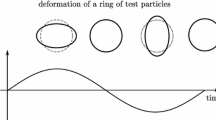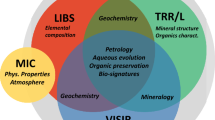Abstract
The terahertz (THz) regime, loosely defined as 0.1–10 THz, is the last frequency window to be fully explored in astronomy. In particular, it is a regime in which there are rich molecular rotation lines and atomic fine structure lines. They are very important tracers for studying the dynamics of astronomical objects such as stars and planetary systems. Observing those spectral lines usually makes use of coherent detectors (i.e., heterodyne mixers). With sensitivity approaching the quantum limit, superconducting mixers have become the coherent detector of choice in THz astronomy. In this paper we mainly introduce the superconducting mixers developed at Purple Mountain Observatory and those for international collaborative projects.
Similar content being viewed by others
References
Zmuidzinas J, Richards P L. Superconducting detectors and mixers for millimeter and submillimeter astrophysics. Proc IEEE, 2004, 92: 1598
Griffiths P R, de Haseth J A. Fourier Transform Infrared Spectrometry. Hobboken: Wiley, 1986
Saleh A A M. Theory of Resistive Mixers. Cambridge, MA: MIT Press, 1971
Tucker J R, Feldman M J. Quantum detection at millimeter wavelengths. Rev Mod Phys, 1985, 57: 1055
Gershenzon E, Gol’tsman G, Gousev Y, et al. Electromagnetic-radiation mixer based on electron heating in resistive state of superconductive Nb and YBaCuO films. IEEE Trans Magn, 1991, 27: 1317
Prober D. Superconducting terahertz mixer using a transition-edge microbolometer. Appl Phys Lett, 1993, 62: 2119–2121
Kerr A, Pan S, Feldman M. Integrated tuning elements for SIS mixers. Int J IR MM Waves, 1986, 9: 203
Büttgenbach T, LeDuc H, Maker P, et al. A fixed tuned broadband matching structure for submillimeter SIS receivers. IEEE Trans Appl Superconduct, 1992, 2: 165
Zmuidzinas J, LeDuc H G, Stern J A, et al. Two junction tuning circuits for submillimeter SIS mixers. IEEE Trans Microw Theory Tech, 1994, 42: 698
Noguchi T, Shi S C, Inatani J. Parallel connected twin SIS junctions for millimeter and submillimeter wave mixers: analysis and experimental verification. IEICE Trans Electron, 1995, E78-c: 481
Tong C, Blundell R, Bumble B, et al. Quantum limited heterodyne-detection in superconducting nonlinear transmissionlines at submillimeter wavelengths. Appl Phys Lett, 1995, 67: 1304
Shi S C, Noguchi T, Inatani J, et al. Experimental results of SIS mixers with distributed junction arrays. IEEE Microw Guid Wave Lett, 1998, 8: 381
Kroug M, Endo A, Tamura T, et al. SIS mixer fabrication fro ALMA band 10. IEEE Trans Appl Superconduct, 2009, 19: 171
Mattis E C, Bardeen J. Theory of the anomalous skin effect in normal and superconducting metals. Phys Rev, 1958, 111: 412
Shi S C, Shan W, Li J. Theoretical simulation of the mixing performance of distributed superconducting tunnel junction arrays at 1.2 THz. IEICE Trans Electron, 2007, E90-C: 556
Shi S C, Noguchi T, Inatani J. A fixed-tuned 100-GHz SIS mixer exhibiting broad bandwidth and very low noise temperature. IEEE Trans Appl Superconduct, 1997, 7: 3850
Huang S P, Li J, Xu J, et al. A 500-GHz superconducting SIS receiver for the portable submillimeter telescope. In: Conference Digest of the 2006 Joint 31st International Conference on Infrared and Millimeter Waves and 14th International Conference on Terahertz Electronics, 2006. 178
Chin C C, Wang M J, Shan W L, et al. A fixed-tuned low-noise 600–700 GHz SIS receiver. Int J IR MM Wave, 2002, 23: 731
Shan W L, Noguchi T, Shi S C, et al. Design and development of SIS mixers for ALMA band 8. IEEE Trans Appl Superconduct, 2005, 15: 503
Shan W L, Shi S C, Matsunaga T, et al. Design and Development of SIS mixers for ALMA band 10. IEEE Trans Appl Superconduct, 2007, 17: 359
Li J, Takeda M, Wang Z, et al. Low-noise 0.5 THz all-NbN superconductor-insulator-superconductor mixer for submillimeter wave astronomy. Appl Phys Lett, 2008, 92: 222504
Li J, Takeda M, Wang Z, et al. Characterization of the mixing performance of All-NbN superconducting tunnel junctions at 0.5 THz. IEEE Trans Appl Superconduct, 2009, 19: 417
Takeda M, Shan W L, Kojima T, et al. Mixing properties of NbN-based SIS mixers with NbTiN wirings. IEEE Trans Appl Superconduct, 2009, 19: 436
Merkel H, Khosropanah P, Yagoubov P, et al. A hotspot mixer model for phonon-cooled NbN hot electron bolometric mixers. IEEE Trans Appl Superconduct, 1999, 9: 4201
Floet D W, Miedema E, A Baselmans J J, et al. Resistive states of superconducting hot-electron bolometer mixers: Charge-imbalance vs. hotspot. IEEE Trans Appl Superconduct, 1999, 9: 3749–3752
Tretyakov I, Ryabchun S, Finkel M, et al. Low noise and wide bandwidth of NbN hot-electron bolometer mixers. Appl Phys Lett, 2011, 98: 033507
Jiang L, Zhang W, Li N, et al. Characterization of the performance of a quasi-optical NbN superconducting HEB mixer. IEEE Trans Appl Superconduct, 2007, 17: 395
Miao W, Delorme Y, Feret A, et al. Comparison between hot spot modeling and measurement of a superconducting hot electron bolometer mixer at submillimeter wavelengths. J Appl Phys, 2009, 106: 103909
Zhang W, Khosropanah P, Gao J R, et al. Quantum noise in a terahertz hot electron bolometer mixer. Appl Phys Lett, 2010, 96: 111113
Zhang W, Khosropanah P, Gao J R, et al. Noise temperature and beam pattern of an NbN hot electron bolometer mixer at 5.25 THz. J Appl Phys, 2010, 108: 093102
Khosropanah P, Zhang W, Hovenier J N, et al. 3.4 THz heterodyne receiver using a hot electron bolometer and a distributed feedback quantum cascade laser. J Appl Phys, 2008, 104: 113106
Zhang W, Miao W, Yao Q J, et al. Spectral response and noise temperature of a 2.5 THz spiral antenna coupled NbN HEB mixer. In: Superconductivity Centennial Conference, Den Haag, 2011
Miao W, Zhang W, Delorme Y, et al. Non-uniform absorption of terahertz radiation in superconducting hot electron bolometer mixers. In: Superconductivity Centennial Conference, Den Haag, 2011
Author information
Authors and Affiliations
Corresponding author
Additional information
SHI ShengCai was born in 1964. He received the Ph.D. degree in 1996 from the Graduate University for Advanced Studies, Japan, in radio astronomy. He joined Purple Mountain Observatory (PMO) in 1988, where he was engaged in the research and development of microwave and millimeter-wave receivers for a 14-m mm-wave radio telescope. He has been with Nobeyama Radio Observatory, National Astronomical Observatory of Japan from 1992–1998. He moved back to PMO in 1998 and is leading the Mm- & Submm-wave Lab there. His current research interests include superconducting device and detector technology, Gaussian optics and quasi-optical system design, and 3-D electromagnetic problems.
Rights and permissions
About this article
Cite this article
Shi, S. Development of superconducting mixers for THz astronomy. Sci. China Inf. Sci. 55, 120–126 (2012). https://doi.org/10.1007/s11432-011-4514-2
Received:
Accepted:
Published:
Issue Date:
DOI: https://doi.org/10.1007/s11432-011-4514-2




